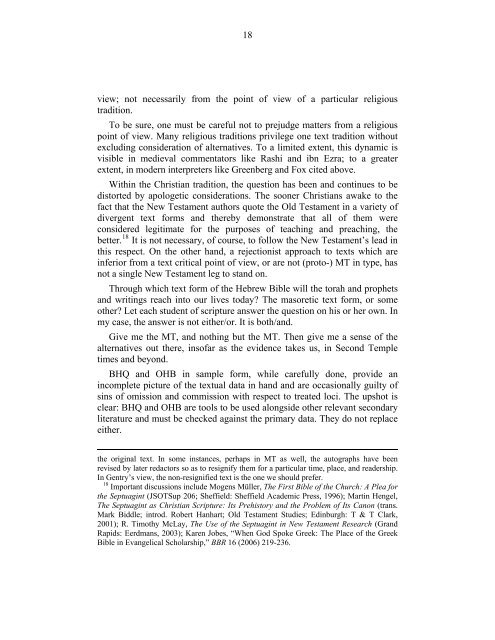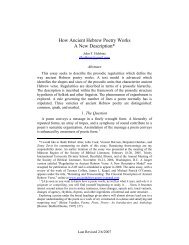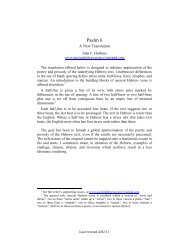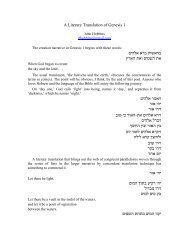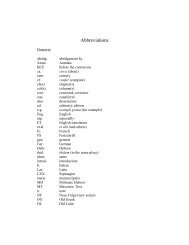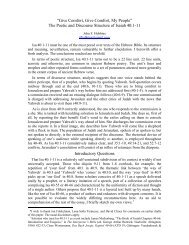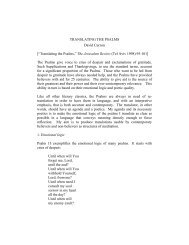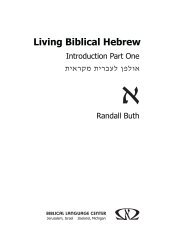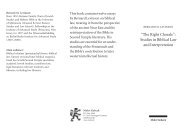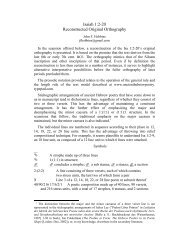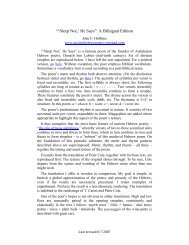Whither Biblia Hebraica Quinta - Ancient Hebrew Poetry
Whither Biblia Hebraica Quinta - Ancient Hebrew Poetry
Whither Biblia Hebraica Quinta - Ancient Hebrew Poetry
- No tags were found...
You also want an ePaper? Increase the reach of your titles
YUMPU automatically turns print PDFs into web optimized ePapers that Google loves.
18view; not necessarily from the point of view of a particular religioustradition.To be sure, one must be careful not to prejudge matters from a religiouspoint of view. Many religious traditions privilege one text tradition withoutexcluding consideration of alternatives. To a limited extent, this dynamic isvisible in medieval commentators like Rashi and ibn Ezra; to a greaterextent, in modern interpreters like Greenberg and Fox cited above.Within the Christian tradition, the question has been and continues to bedistorted by apologetic considerations. The sooner Christians awake to thefact that the New Testament authors quote the Old Testament in a variety ofdivergent text forms and thereby demonstrate that all of them wereconsidered legitimate for the purposes of teaching and preaching, thebetter. 18 It is not necessary, of course, to follow the New Testament’s lead inthis respect. On the other hand, a rejectionist approach to texts which areinferior from a text critical point of view, or are not (proto-) MT in type, hasnot a single New Testament leg to stand on.Through which text form of the <strong>Hebrew</strong> Bible will the torah and prophetsand writings reach into our lives today? The masoretic text form, or someother? Let each student of scripture answer the question on his or her own. Inmy case, the answer is not either/or. It is both/and.Give me the MT, and nothing but the MT. Then give me a sense of thealternatives out there, insofar as the evidence takes us, in Second Templetimes and beyond.BHQ and OHB in sample form, while carefully done, provide anincomplete picture of the textual data in hand and are occasionally guilty ofsins of omission and commission with respect to treated loci. The upshot isclear: BHQ and OHB are tools to be used alongside other relevant secondaryliterature and must be checked against the primary data. They do not replaceeither.the original text. In some instances, perhaps in MT as well, the autographs have beenrevised by later redactors so as to resignify them for a particular time, place, and readership.In Gentry’s view, the non-resignified text is the one we should prefer.18 Important discussions include Mogens Müller, The First Bible of the Church: A Plea forthe Septuagint (JSOTSup 206; Sheffield: Sheffield Academic Press, 1996); Martin Hengel,The Septuagint as Christian Scripture: Its Prehistory and the Problem of Its Canon (trans.Mark Biddle; introd. Robert Hanhart; Old Testament Studies; Edinburgh: T & T Clark,2001); R. Timothy McLay, The Use of the Septuagint in New Testament Research (GrandRapids: Eerdmans, 2003); Karen Jobes, “When God Spoke Greek: The Place of the GreekBible in Evangelical Scholarship,” BBR 16 (2006) 219-236.


